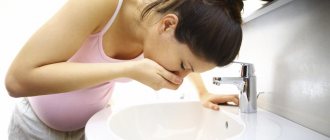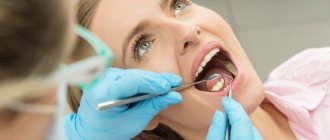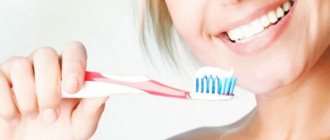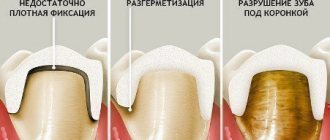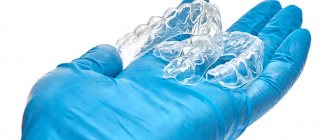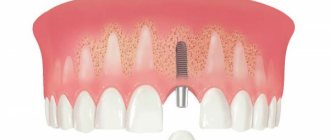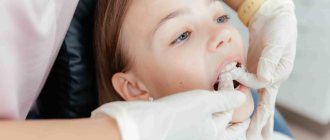Malocclusion is one of the most common problems of the dental system. More than 80% of patients have malocclusion, expressed in one form or another. In many cases, the pathology is not pronounced and generally does not cause aesthetic discomfort to the patient, so the patient is in no hurry to correct the bite in dentistry. It is important to understand that bite problems, even the most minor ones, must be corrected, since any anomaly affects the normal functioning of the entire dental system.
Why is bruxism dangerous?
Bruxism is uncontrollable grinding or clenching of teeth due to spasms in the chewing muscles. This is a fairly common phenomenon, but not all patients realize that the disease poses serious problems:
- pathological abrasion of tooth enamel;
- loss of fillings, crowns;
- dysfunction of the temporomandibular joint (clicking, pain when opening/closing the mouth);
- chronic insomnia and fatigue;
- headaches, dizziness.
Teeth grinding is mainly characteristic of the night, when a person is sleeping and does not control the movements of the jaw. However, in many patients the problem also manifests itself during the day - they involuntarily clench their teeth under stress or when concentrating.
Elimination methods
To eliminate the gag reflex, you need to find out the cause, and then take actions aimed at eliminating it. Methods to combat the gag reflex:
- replacing toothpaste with a composition with a different flavor, for example, mint paste with a product with a fruit flavor;
- replacing a brush with a different stiffness and type of bristles;
- When cleaning, do not touch the area of the tongue, when pressed, a reflex appears;
- Do not press the brush against the buccal mucosa.
If the vomiting effect is accompanied by pain and other unpleasant sensations, it is recommended to visit a doctor. There is a possibility that the condition is caused by soft tissue diseases and the need to treat pathology.
In children, this condition is caused by stress or fear of the cleaning procedure. The child needs to be reassured and oral care should be started in the form of an exciting game that will not cause fear.
How is bruxism treated?
If a problem occurs, you should contact an orthodontist. He will select a special mouth guard to wear while you sleep. It is an elastic dental splint made of biocompatible plastic. This orthodontic design responds to the load when the patient compresses the dentition, preventing the chewing muscles from overexerting. As a result, the lower jaw relaxes and muscle hypertonicity goes away. Treatment will be effective if you wear the mouth guard for at least 10 hours a day.
Reasons for the development of the gag reflex
The reasons for the appearance of a gag reflex when caring for the oral cavity are:
- Pregnancy. Women often experience unusual reactions during this period. The taste of the paste can cause severe nausea and make you feel unwell.
- Stress. The body in this condition may not respond correctly to irritants, including brushing teeth, using mouthwash, toothpaste or floss.
- Smell. The care products have a sharp, pronounced aroma. These scents are not suitable for everyone, especially for some specific ingredients.
- Taste. This characteristic of cleaning products is also not suitable for everyone. The only option is an individual choice of composition with an optimal, tolerable taste.
- Mechanical impact. Brushes with different types of bristles can irritate the mucous membrane, causing a gag reflex.
- Fluorine. This element provides protection to the enamel, but it is what causes nausea in many people.
Purposes of using a night guard
- Prevent abrasion of tooth enamel.
- Relieve tension in the chewing muscles of the jaw.
- Normalize the functioning of the temporomandibular joint.
Often, wearing a sleep guard is the first step in correcting your bite and precedes the installation of braces. And in some cases, mouthguards are worn when braces are already installed to protect them from accidental breakage due to involuntary clenching of the jaws. They can also serve as protection for crowns and fixed dentures.
Who is recommended to wear a mouth guard?
It is important to understand that the condition of the entire oral cavity depends on how many more serious anomalies are present in the patient. Problems such as stomatitis, dysfunction of swallowing and chewing, breathing disorders, facial expressions, tongue injuries and many others are a consequence of malocclusion. Treatment of anomalies must be carried out in a timely manner, using a method suitable for a particular patient. The most appropriate time for correcting malocclusions is childhood, however, it is also possible to correct the position of the jaws in adult patients. Indications for treatment with capami are the same in both children and adults. Indications for wearing a mouth guard include minor gaps between teeth, the presence of teeth that are on top of each other, incorrect position of a tooth or teeth in a row, twisted or rotated teeth, and minor malocclusions. Also, mouthguards for correcting teeth are prescribed as a preventive measure against relapse of tooth displacement after the bite has been corrected with a braces system. The time required for bite correction varies between adults and children. Treatment of malocclusions in children is carried out much faster than in adults. But, for children's treatment, trainers are used to a greater extent, and only at an older age can mouth guards be used. Since the mouthguard is easy to use and can be easily removed and put on, it is often prescribed to adolescents and children aged 10-12 years.
Mouthguards do not cause discomfort or pain, are invisible to people around them, do not affect the enamel and do not injure the gums. Thanks to these factors, mouthguards today occupy one of the leading positions among methods for correcting minor malocclusions. It is worth noting that mouth guards are not suitable for all patients; the individual characteristics of each patient play a large role. If we talk about contraindications to wearing a mouth guard, then it is worth noting such a factor as individual intolerance to the components from which the structure is made. Contraindications also include the presence of problems such as mental and nervous disorders, epilepsy.
Custom mouthguards for bruxism
These are orthodontic structures that are made in a dental laboratory based on impressions of the jaw of a particular patient. They are used in severe cases of the disease, when the symptoms of bruxism are significantly pronounced and serious correction of the dentition is required. The more accurately the design is selected, the more effectively it affects the jaw muscles. Usually, after the patient puts on a dental guard, 10-15 minutes are enough for the muscle spasm to go away and the headache or neck pain to subside. The downside of these structures is that they take quite a long time to produce - up to several weeks, and the patient often needs to start treatment as soon as possible.
Stages
Nausea when brushing your teeth is usually a defensive reaction that is triggered by an irritant, for example, the strong taste of toothpaste. The mechanism of development is quite simple - when cleaning, discomfort is felt, while the person looks at himself in the mirror. A signal is sent to the brain and a reaction develops in the form of vomiting to eliminate the irritant.
The reflex develops through four stages:
- the condition worsens, irritability, fatigue appear, and there is a urge to vomit;
- nausea develops;
- after vomiting there is relief;
- in the intervals between deteriorations, the person feels normal.
General overview
An unloading tray is an overlay made of elastic material that follows the shape and fits tightly along the entire length of the dentition, the task of which is to redistribute the load on the jaw region. The installed orthodontic apparatus helps relieve pain, eliminate muscle hypertonicity, as well as normalize the occlusal relationship and jaw balance.
The use of biocompatible materials eliminates the development of an allergic reaction and a health hazard when wearing the corrector for a long time. The ease of removal and installation makes the use of the mouthguard comfortable even for patients of a younger age group, and the aesthetic appearance eliminates the psychological problems inherent in wearing permanent corrective structures.
What can a doctor do to reduce the gag reflex?
- Lidocaine. The drug is used for local anesthesia. Lidocaine sprays or gels are usually used.
- Local anesthesia of the palate. This method is used on the upper jaw.
- Conduction anesthesia of the lower jaw. After the administration of the anesthetic, the patient’s cheeks, gums, tongue, and lower lip become numb. Their sensitivity decreases, the doctor is able to carry out therapeutic manipulations normally.
During dental treatment, salivation often increases. Saliva gets onto the root of the tongue, and this increases nausea. To ensure patient comfort, the dentist removes saliva using a saliva ejector. If the reflex is pronounced, you can change the patient’s position and treat him while sitting. This way, less saliva reaches the root of the tongue.
Not only therapeutic procedures, but also diagnostic procedures and impressions before prosthetics or restoration can cause nausea. Here, a lot depends on the methods and equipment used in the clinic.
The 32 Dent clinic uses a new intraoral scanner, Medit 500. It allows you to make a 3D model of your teeth. For the patient, this method offers many advantages compared to traditional impressions:
- Scanning comfort. No powder is needed when using the Medit 500 intraoral scanner. The entire scanning procedure takes place quickly and continuously. The device has a small nozzle, which also reduces the risk that the patient will experience nausea during insertion of a foreign object into the oral cavity.
- High accuracy of results. The Medit 500 intraoral scanner allows you to obtain high-resolution images with minimal error. Thanks to this, the doctor is able to accurately assess the condition of the oral cavity and not carry out additional diagnostic procedures.
- High speed. The image obtained during scanning is immediately displayed on the monitor. In order to obtain a 3D model of the oral cavity, approximately 2 minutes are enough - about a minute for one jaw. Even if the patient has a strong gag reflex, in most cases, attacks of nausea do not occur in such a short period.
- Possibility to interrupt scanning and start it from the desired point. The Medit 500 intraoral scanner is turned on and off with a button. If the patient feels nausea or vomiting. The doctor can take a break and continue the scan from where he left off.
The use of modern intraoral scanners helps our doctors make not only treatment, but also diagnostic procedures comfortable.
What can a patient do to reduce the gag reflex?
If you know that you have a pronounced gag reflex, you can prepare for your visit to the dentist in advance. For this you can use medications:
- 4-5 days before visiting the dentist you can take Cerucal and Motilium. In the first days, take half a tablet, and the day before your appointment, take a whole tablet.
- Cerucal can be taken without other medications. In this case, we recommend taking 1 tablet three times a day the day before your appointment, and on the day of visiting the dentist, take one tablet.
- Any medications for motion sickness.
- The night before and on the day of the visit, you can take two Adaptol tablets.
All of these drugs can effectively combat nausea. Usually, if the attacks are caused by fear, it is enough to take medications before 2-3 appointments with the doctor. After this, in most cases, the strong gag reflex that interferes with normal dental treatment goes away.
When nausea is not severe, you can do without pills:
Before dental treatment, it is better not to eat or drink for two hours.
Since nausea is caused by impaired nasal breathing, instill drops that relieve nasal congestion. It is better to do this right before starting treatment.
Rinsing your mouth with soda, salt, mint or eucalyptus-flavored solutions helps to cope with strong salivation.
If you start feeling sick during dental treatment, try to switch your attention. Sometimes shaking your leg is enough to do this. You can block vomiting by breathing. To do this, you need to inhale through your nose and exhale through your mouth.
The dentist must be warned that you have a pronounced gag reflex. This will help the doctor choose the best method to solve the problem. It is often enough to simply reassure the patient or book him in for the second half of the day, since by this time the gag reflex is reduced.
Symptoms
The list of symptoms characteristic of the primary stage of development of abnormalities caused by pathologies of the temporomandibular joint includes:
- Deterioration in health, feeling of permanent fatigue and apathy;
- Increased body temperature, up to a feverish state;
- Severe speech and hearing problems when communicating with others;
- The occurrence of extraneous sounds during jaw movements;
- Painful sensations, swelling, severe discomfort.
The use of an unloading tray is recommended in situations where the identified pathology is in the initial stage of development. For more complex clinical indications, complex therapy is required to eliminate negative symptoms, including the possibility of surgical intervention.
Wearing Features
Modern mouthguards are easy to use. The use of computer diagnostic technologies makes it possible to establish the position of the jaws and determine the presence of occlusal anomalies. The examination, as well as subsequent treatment, involves the use of special devices that guarantee the accuracy of the results obtained.
The absence of discomfort when wearing is due to the use of three-dimensional modeling technology using digital equipment. A comprehensive scan of the oral cavity, together with the production of anatomically accurate casts, allows us to achieve full compliance and calculate the correct distribution of mechanical load on the temporomandibular joint, ensuring the release of pressure from the nerve endings and restoration of the natural position of the lower jaw.
In situations where the priority goal is pain relief, the system can only be used at night. In this case, a full correction course involves wearing a mouth guard for 6-8 months, with a daily norm of at least 20-22 hours. Proper use of the product allows you to reduce the load on the neck and back muscles, improve coordination and balance during movement, and also eliminate the possibility of displacement of the TMJ or vertebrae.

